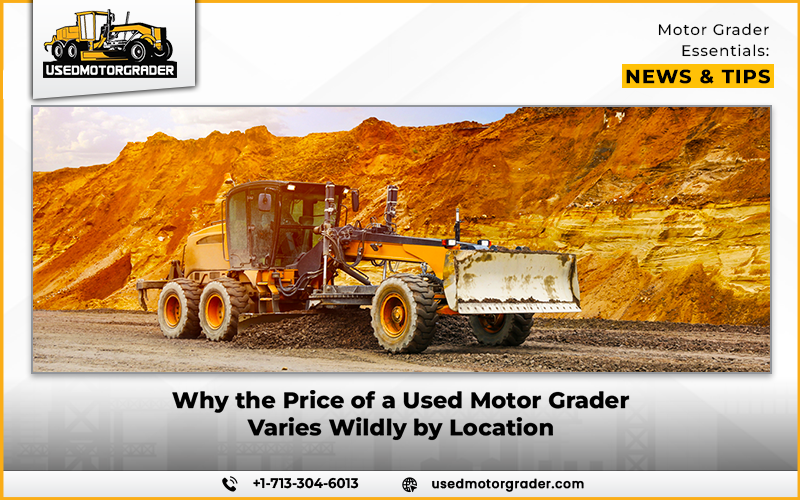It’s a situation more common than you’d think. You’re scrolling through listings for a used motor grader, and you notice a dramatic spread in prices. Two nearly identical machines, same brand, similar hours, same year, yet one costs $40,000 more. The reason? Location. Where a motor grader is based can have just as much influence on its price as its specs, condition, or hours. And understanding why that’s the case can help contractors and fleet managers make smarter decisions when buying or selling.
Local Demand Shapes the Market: Industry Needs Drive Value
At the core of location-based price swings is regional demand. Not every market has the same appetite for heavy machinery, and motor graders are no exception. In areas where roadbuilding, mining, or energy infrastructure is booming, graders get snapped up fast, and prices rise accordingly. A region flooded with private development or DOT highway expansion will place a premium on reliable, mid-hour machines. Meanwhile, in quieter agricultural or municipal zones, demand might be steady but less intense, leading to softer price tags. What’s in demand where you are plays a major role in what a grader is worth there.
Climate Is a Hidden Influencer on Machine Longevity
The climate a machine has worked in tells a story, and buyers are listening. Used graders from dry, arid states tend to command higher prices because they’re less likely to suffer from rust, frame rot, or hidden corrosion. Harsh winters, coastal humidity, or road salt exposure can take their toll on frames, undercarriages, and hydraulic systems. Even when cosmetic rust is addressed, savvy buyers know environmental wear lingers beneath the surface. That’s why a machine from a desert state might sell for more than one from a snowbelt region, even with the same hours. Preservation matters.
Transportation Costs: Proximity Still Matters in a Digital Marketplace
In today’s online-heavy equipment world, it’s tempting to think buyers will search nationally for the best deal. But distance still matters, mainly because moving a 40,000-pound grader isn’t cheap. Transport costs, permits, and logistics can add thousands to a transaction. Buyers often prefer sourcing closer to home, especially if it means avoiding border crossings or oversized load headaches. A slightly higher local price can actually be cheaper in the end when factoring in freight. That proximity premium shows up subtly in listings, and it’s a major contributor to price variation.
Emissions Regulations and State Compliance
Not all motor graders are emissions-equal. States with strict environmental rules, like California or parts of the Northeast, require machines to meet Tier 4 Final emissions standards. Older models that still run well might be non-compliant, limiting their use or sale within those regions. As a result, a solid pre-Tier 4 grader might be worth less locally than it would be in a region with more lenient regulations. On the flip side, newer emissions-compliant models may fetch a premium in states with tighter controls. Compliance drives value, and not every region plays by the same rules.
Dealer Networks and Aftermarket Support
Another behind-the-scenes factor in a used motor grader pricing is local dealer infrastructure. In areas where a particular OEM has strong dealer coverage, offering parts, service, and support, buyers are more comfortable purchasing that brand. That comfort translates to higher resale value. A Volvo grader in an area with five nearby Cat dealerships might sell for less than it would in a Volvo-heavy zone. Buyers think about service accessibility, downtime risks, and future support when making offers. A well-supported grader just feels safer to own, and that security often shows up in the price.
Seasonal Sales Trends and Construction Cycles
Timing can make a big difference, too. Demand for graders normally declines during the winter season in northern climates, usually between December and March, when construction is suspended. It is possible that prices ease a little in those slower months, particularly when sellers have an incentive to clear stock ahead of the season getting into full swing. By contrast, the warmer southern markets do not exhibit the same seasonal fluctuations, and price steadiness is observed throughout the year. This cycle affects both the buyers and sellers. Advertising a used motor grader sale during the late spring or early summer may attract higher bids, particularly in markets where the work is just getting into full swing.
Thinking Beyond the Machine’s Specs
The price of used equipment is not all about what is under the hood or the number of hours on the meter. It is a question of context, in which the machine was operated, what the market situation is in the region, how transportable it is, and what the buyer says about its durability and conformity. Each of these location factors informs pricing strategies, frequently in ways that are not immediately obvious to sellers. Anyone in the market, whether purchasing a workhorse or attempting to sell one, will be glad to consider not only mechanical but regional values. The grader can remain the same, though the landscape surrounding it is in a constant state of change.


